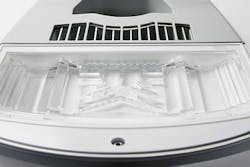The light-guide-based RSW LED street light family now includes models that extend to 210W and 23,000 lm while the packaged LED business within Cree has rolled out the third-generation of the XP-G LED family.
Cree has announced three new models in the RSW Series of LED-based street lights that are notable for using light-guide technology that Cree calls WaveMax to deliver pleasing diffuse light with no glare, and the products will be on display at LightFair International (LFI) next week. Lighting designers/specifiers can now replace up to 400W HID sources with the solid-state lighting (SSL) product family delivering up to 23,000 lm at 210W. Meanwhile, Cree has also announced the XLamp XP-G3 packaged LED family that exceeds 200 lm/W in efficacy.
Interested in more articles & announcements on LED & lighting applications?
Cree first rolled out the low-power members of the RSW Series back in March and at the time touted the new design as being a good option as municipalities seek to install outdoor lighting that is friendlier to human eyes and the environment. The WaveMax-based design is entirely different from the more typical SSL street lights that rely on individual LEDs topped with total internal reflection (TIR) lenses to form the desired beam pattern. The visible point sources are unpleasant to look at directly, whereas Cree vice president of product marketing Erik Milz said, "You can look right at these where you never could with street lights before" referring to the RSW Series.
We have learned much more about the RSW LED street light family subsequent to that initial product launch. Cree had touted both the glare-free benefits and the fact that the new products were readily available in 3000K CCT, with many dark-sky advocates pushing municipalities to specify such warmer fixtures thereby reducing the blue energy in the spectrum that can potentially interfere with human circadian rhythms, the environment, and astronomers.
In our original coverage we proclaimed that the warmer CCT and light-guide technology were somewhat separate from a technology perspective, but were both simply features of the RSW Series. It turns out that statement is not entirely true. To deliver the warm CCT in the most efficient manner, Cree is using a mix of off-white LEDs and red LEDs to deliver the 3000K and 4000K CCT options in the RSW family. That LED mixing technique is not new in general, but we haven't seen it applied outdoors before now.
Cree has long used what it calls blue-shifted-yellow (BSY) LEDs combined with red LEDs in some of its TrueWhite-branded indoor products with the mix being touted as the most-efficient way to deliver 90 CRI light. Indeed, the TrueWhite brand implies 90 CRI. In the case of the RSW fixtures, the LED mix is used to efficiently deliver the warmer CCT, but only 80 CRI, although that is still better color rendering than is found in typical outdoor products. The BSY LEDs are phosphor-converted LEDs that are made like white LEDs, but the phosphor mix is shifted from the black-body locus to the yellow region.
Warm CCT and diffuse light
The reason that the warm CCT and glare-free light features are intertwined from a technology perspective is that the mixing requires some optical tricks. You couldn't easily mix the LEDs under TIR lenses in a traditionally-architected outdoor LED luminaire. Indoor products that mix such LEDs typically use some sort of a mixing chamber. In the case of the RSW Series, the WaveMax light guide handles the mixing.
Cree, and for sure other outdoor SSL manufacturers, are feeling pressure from groups such as the International Dark Sky Association (IDA) to offer warmer options. In fact, the IDA has published requirements for a fixture seal of approval that requires 3000K or warmer CCT. Cree's Milz said, "There's a lot of chatter about it," referring to swaying public opinion on warmer CCTs. With the RSW he said, "We're trying to get ahead of those comments."
But the light guide also delivers a more pleasing light distribution. The optic is molded in one piece but has many facets, or small planar surfaces, that are designed at different angles to deliver the required beam. Milz said, "It's not just about warmer CCT. It's about better light."
For now, Cree is only offering Type 2 medium and long and Type 3 medium distributions. Milz said the company will slowly build out the portfolio of beam distributions, but each will require a new custom version of the WaveMax optic.
Indeed, for all of the benefits of the new design, there are several drawbacks that could impact the cost of the product. The optic situation is clearly more complex than the days of just picking the right mix of TIR lenses for a product to deliver the desired beam. The BSY plus red design requires a driver with two channels and two sets of LEDs. Still, Milz said the market has price expectations and Cree would be competitive in the market with the new product. Some innovations such as the use of a bulk molding compound in place of aluminum in the housing will help offset the complexity of the light engine.
What the new design will offer is equivalent efficacy in 3000K- and 4000K-CCT products and competitive efficacy with legacy TIR-based products in even cooler CCTs. The already shipping 30W and 50W products deliver 115 lm/W in either of the CCT options.
The XLamp XP-G3 family
Moving to packaged LEDs, it was somewhat surprising to see Cree roll out the XP-G3 LED family. Back in March, Cree had extended the performance of the XP-G2 LED family to 586 lm. And the newer XP-L LEDs were considered the follow-on product to the XP-G Series. But clearly some customers would like to continue using the exact same packaged LED family at higher performance levels.
"We are designing a new series of 130-lm/W high performance street lights and the choice to use the new Cree XP-G3 LED was clear," said Wilbur Tarn, director of OrangeTeK. "The XP-G3 LED delivers high efficacy and high reliability in the familiar XP-G footprint, allowing us to modify elements of an existing design to shorten our design time by half."
The XP-G3 is based on Cree's SC5 (Silicon Carbide 5) technology platform. The packaged LED can deliver 205 lm/W at 350 mA of drive current and 863 lm at 2A. Moreover, since it is a follow-on product in a series, Cree already has 6000 hours of LM-80 data that suggests L90 lifetime beyond 50,000 hours even when the LED is operated at 105°C and 1.5A.







